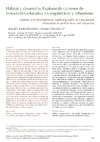Identificador persistente para citar o vincular este elemento:
https://accedacris.ulpgc.es/jspui/handle/10553/35395
| Campo DC | Valor | idioma |
|---|---|---|
| dc.contributor.author | Martín Hernández, Manuel | en_US |
| dc.contributor.author | Díaz García, Vicente | en_US |
| dc.date.accessioned | 2018-04-16T10:22:05Z | - |
| dc.date.available | 2018-04-16T10:22:05Z | - |
| dc.date.issued | 2017 | en_US |
| dc.identifier.issn | 2173-125X | en_US |
| dc.identifier.uri | https://accedacris.ulpgc.es/handle/10553/35395 | - |
| dc.description.abstract | Han pasado dos décadas desde que aparecieron las primeras asignaturas que incorporaban la habitabilidad básica o la cooperación al desarrollo en la formación del arquitecto en España. Desde entonces, las escuelas de arquitectura han ido incorporando contenidos que son cada vez más demandados, tanto por la sociedad como por los propios alumnos. La crisis económica iniciada en 2008, o los Objetivos de Desarrollo Sostenible aprobados en 2015 por Naciones Unidas, nos deben hacer reflexionar sobre la centralidad de estos temas en la formación de la arquitectura y el urbanismo. Desde el año de su creación, en 2001, la asignatura optativa Hábitat y desarrollo se ha propuesto visibilizar la arquitectura social como una parte importante en la formación del arquitecto, en la que se prioriza el proceso arquitectónico, íntimamente relacionado con el habitar (el habitante, los hábitos y su relación con el lugar), frente al producto (el objeto, el edificio, como una síntesis formal de esa arquitectura). En la asignatura se hace una lectura del papel que la cooperación al desarrollo puede jugar en la formación del arquitecto. La participación ciudadana es otro de los temas transversales que se incorporan en la asignatura, formando a los estudiantes en técnicas específicamente aplicables al campo de la arquitectura y del urbanismo. Hábitat y desarrollo se imparte en el primer semestre de quinto curso del grado en arquitectura de la Universidad de Las Palmas de Gran Canaria. | en_US |
| dc.description.abstract | Habitat and development. Exploring paths of educational innovation in architecture and urbanism. It has been two decades since the first subjects that incorporated basic habitability or development cooperation appeared in the training of the architect in Spain. Since then the schools of architecture have been incorporating content that is increasingly demanded by both society and students themselves. The economic crisis initiated in 2008 or the Sustainable Development Objectives approved in 2015 by the United Nations should make us reflect on the centrality of these issues in the formation of architecture and urbanism. Since the year of its creation, in 2001, the optional Habitat and Development has been proposed to make visible the social architecture as an important part in the architect's training, in which the architectural process is prioritized, closely related to the habitat (the inhabitant, the habits and their relation to the place), in front of the product (the object, the building, as a formal synthesis of that architecture). The subject makes a reading of the role that development cooperation can play in the training of the architect. Citizen participation is another of the cross-cutting themes that are incorporated into the subject by training students in techniques specifically applicable to the field of architecture and urbanism. Habitat and development is taught in the first semester of fifth year of the degree in architecture of the University of Las Palmas de Gran Canaria. | en_US |
| dc.language | spa | en_US |
| dc.relation.ispartof | Habitat Y Sociedad | en_US |
| dc.source | Hábitat y Sociedad. [ISSN 2173-125X], n. 10, p. 113-128 | en_US |
| dc.subject | 6201 Arquitectura | en_US |
| dc.subject.other | Hábitat | en_US |
| dc.subject.other | Cooperación al desarrollo | en_US |
| dc.subject.other | Arquitectura social | en_US |
| dc.subject.other | Participación ciudadana | en_US |
| dc.subject.other | Mediación urbana | en_US |
| dc.subject.other | Habitat | en_US |
| dc.subject.other | Development cooperation | en_US |
| dc.subject.other | Social architecture | en_US |
| dc.subject.other | Citizen participation | en_US |
| dc.subject.other | Urban mediation | en_US |
| dc.title | Hábitat y desarrollo. Explorando caminos de innovación educativa en arquitectura y urbanismo | en_US |
| dc.title.alternative | Habitat and development. Exploring paths of educational innovation in architecture and urbanism | en_US |
| dc.type | info:eu-repo/semantics/Article | en_US |
| dc.type | info:eu-repo/semantics/Article | es |
| dc.type | Article | es |
| dc.identifier.doi | 10.12795/HabitatySociedad.2017.i10.07 | |
| dc.identifier.isi | 000424573100007 | - |
| dc.description.lastpage | 128 | - |
| dc.identifier.issue | 10 | - |
| dc.description.firstpage | 113 | - |
| dc.investigacion | Ingeniería y Arquitectura | en_US |
| dc.type2 | Artículo | en_US |
| dc.contributor.daisngid | 9710535 | |
| dc.contributor.daisngid | 31451182 | |
| dc.contributor.wosstandard | WOS:Hernandez, MJM | |
| dc.contributor.wosstandard | WOS:Garcia, VJD | |
| dc.date.coverdate | Noviembre 2017 | |
| dc.identifier.ulpgc | Sí | es |
| dc.description.esci | ESCI | |
| dc.description.erihplus | ERIH PLUS | |
| item.grantfulltext | open | - |
| item.fulltext | Con texto completo | - |
| crisitem.author.dept | GIR TIDES: URSCAPES | - |
| crisitem.author.dept | IU de Turismo y Desarrollo Económico Sostenible | - |
| crisitem.author.dept | Departamento de Arte, Ciudad y Territorio | - |
| crisitem.author.orcid | 0000-0002-8073-6338 | - |
| crisitem.author.parentorg | IU de Turismo y Desarrollo Económico Sostenible | - |
| crisitem.author.fullName | Díaz García, Vicente Javier | - |
| Colección: | Artículos | |
Citas de WEB OF SCIENCETM
Citations
3
actualizado el 08-jun-2025
Visitas
212
actualizado el 27-sep-2025
Descargas
327
actualizado el 27-sep-2025
Google ScholarTM
Verifica
Altmetric
Comparte
Exporta metadatos
Los elementos en ULPGC accedaCRIS están protegidos por derechos de autor con todos los derechos reservados, a menos que se indique lo contrario.
